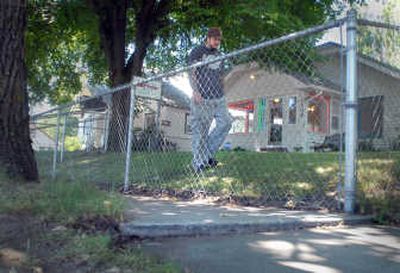Sidewalk repairs fall on residents

Some of Coeur d’Alene’s sidewalks are in such bad shape that city leaders are ordering repairs and invoking a 1909 law that requires adjoining property owners to foot the bill.
City Hall last month sent out 182 letters to residents and business owners informing them they will have to pay to fix cracked and crumbling sidewalks adjacent to their properties.
Left unsaid in the letter is the threat that the city will place a lien on properties whose owners fail to comply.
Repairs will likely average about $2,000 for a 100-foot-long sidewalk, according to city employees’ estimates.
“If it’s my sidewalk, maybe I should put a fence around it and not let anybody walk on it,” said Brad Sawyer, owner of Hooligan Empire Tattoo on North Third Street.
The roots of three maple trees in front of Sawyer’s business have heaved up his sidewalk into angles unacceptable by city code.
Repairs could cost him thousands of dollars.
“It is an expensive thing,” said Kat Mitchell, sales manager with Hometowne Concrete, which does sidewalk repair jobs. She expects to begin receiving calls from property owners soon.
The new program stems from a 2005 realization that Coeur d’Alene was out of compliance with federal accessibility requirements established in the Americans with Disabilities Act.
The City Council voted earlier this year to create new enforcement and repair guidelines with the goal of bringing all sidewalks up to code over the next 20 years.
The city’s effort this year addresses sidewalks along about 5 ½ miles of city streets.
Private property owners have been financially responsible for maintenance of adjacent sidewalks for almost a century.
But this is the first time in recent memory that the city has made a concerted effort to improve overall walkway conditions.
Under the 1909 city ordinance, property owners are also liable for injuries that occur on sidewalks adjacent to their homes and businesses.
Previously, the city ordered repairs only when a complaint was made or when new construction required inspection. That made for a slow rate of walkway improvement, according to Deputy City Administrator Jon Ingalls.
A desire to speed up the process motivated the changes, he said.
“Block by block, street by street, we’re going to put a dent in getting better maneuverability,” Ingalls said.
The new program is linked to the city’s yearly “street overlay” program.
When a given street is due for a new layer of asphalt, city inspectors will examine adjacent sidewalks and send letters to owners of properties next to offending walkways. Next year, portions of 12 streets will get new pavement and sidewalk inspections.
Those who received letters are expected to hire a concrete contractor to repair sidewalks or to perform the work themselves.
They need to get a $50 permit from the city and have the work approved by an inspector. Work that involves tree roots pushing up the sidewalk may also require a visit from the city’s urban forester.
If the repairs aren’t done within a year, the city will do the work itself and place a lien on the property, payable with the next year’s property taxes. To ease the financial burden, the city is paying for and installing pedestrian ramps at street corners. The City Council also extended the amount of time allowed for the work – now one year instead of 60 days.
Sawyer, the tattoo artist, said he may have reconsidered purchasing his property if he had known he would be responsible for the sidewalk. He said he wished he had protested at City Council meetings when the new program was considered. One of Sawyer’s employees suggested that he charge a toll for access to the sidewalk.
But others were less frustrated.
“It’s no biggie to us,” said Janet Buvel, who received a letter regarding her East Lakeside Avenue home. “It’s our responsibility, same as shoveling.”
Idaho law permits cities to require property owners to pay for sidewalk repair. Many municipalities in the state and beyond place such responsibility on private citizens, according to Ken Harward, executive director of the Association of Idaho Cities.
“That’s pretty common across the country,” Harward said.
The new plan is the best way for the city to “eat this elephant of a problem,” Ingalls said, noting that he expected the city to receive more complaint calls from letter recipients than it has.
More information on the program is available at the city’s Web site, www.cdaid.org.